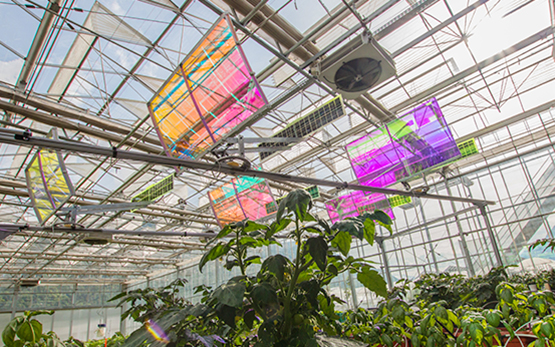To utilise useful light for the vegetables grown in the greenhouse whilst producing electricity: this is possible thanks to the startup Voltiris's agri-photovoltaic system. Agroscope is currently testing this solution for vegetable crops requiring especially high levels of light at its Conthey site.
Existing agri-photovoltaic solutions capture part of the sun’s incidence and convert it into electricity. However, the structures of photovoltaic systems cause a partial shading, which represents a problem for most greenhouse vegetable crops, since they need high levels of light to achieve the desired yields.
Filtering the colours of the light spectrum that are useful for plants
How do we reconcile energy generation and greenhouse agricultural production without triggering a competition? The innovative solution developed by the startup Voltiris and currently being tested on Agroscope’s Conthey site provides an answer to this question. The system filters spectrally sunlight: the light components required by plants to grow, i.e. the ‘useful’ colours, are transmitted to the plants, whilst the other ‘non-useful’ colours are focalised on a small photovoltaic module to generate electricity. In this way, the entire light spectrum is utilised.
A selective use of colours to grow vegetables is already known from indoor farming: growers mainly use red and blue LEDs to limit their electricity consumption.
Continuously tracking the sun
Installed on existing greenhouse structures, the technology being tested at Agroscope causes less than 10% partial shading. Moreover, it optimises electricity production, since the panels allow a continuous and dynamic tracking of the sun.
Summer and winter crops
The pilot project was launched this spring with tomato, pepper and basil crops. It continues this winter with salad crops. Funded by Innosuisse, the trial aims to quantify the impact of the Voltiris’ solution in terms of plant growth, development and yields of the different crops. The HES-SO Valais/Wallis will evaluate and study the potential benefits of the solution from an energy perspective.
Aiming for carbon-neutral greenhouses in 2050
Greenhouse production must also undertake a transition to ‘greener’ energies. This innovative technology contributes to the achievement of the target of carbon-neutral greenhouses in Switzerland by 2050, namely by promoting the effective production of renewable energy.






